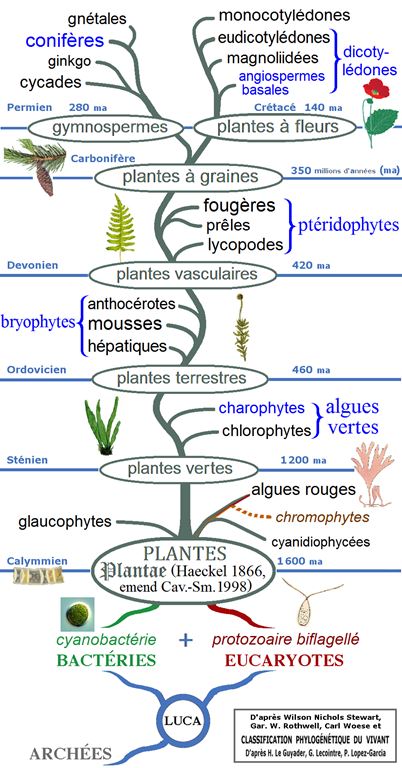Myrthe du Chili
(Luma apiculata)
![Illustration Luma apiculata, Curtis´s Botanical Magazine (vol. 84 [ser. 3, vol. 14]: t. 5040, 1858) [W.H. Fitch], via plantillustrations.org](inc/images/illustrations/1115.jpg)
-7-8°C (-10°C selon ribanjou)
Un grand arbuste ou petit arbre. Il atteint une hauteur de 6 à 20 m. Il peut être cultivé comme haie de 3 m de haut s'il est taillé. L'écorce est brune et s'écaille. Les ... (traduction automatique)
→suite
Myrthe du Chili 

Note alimentaire ![]()
![]()
![]()
Un grand arbuste ou petit arbre. Il atteint une hauteur de 6 à 20 m. Il peut être cultivé comme haie de 3 m de haut s'il est taillé. L'écorce est brune et s'écaille. Les feuilles sont vert olive foncé et brillantes. Ils mesurent 25 mm de long. Les petites fleurs ont environ 150 étamines. Les fruits sont petits ... (traduction automatique) →suite
Pas d'autre illustration
pour le moment 😕
Classification
- Classique : en haut de l\'écran, sous le coeur.
- Phylogénétique :
- Clade 4 : Angiospermes ;
- Clade 3 : Dicotylédones_vraies ;
- Clade 2 : Rosidées ;
- Clade 1 : Malvidées ;
- Ordre APN : Myrtales ;
- Famille APN : Myrtaceae ;
Illustration : cet arbre phylogénétique des plantes montre les principaux clades et groupes traditionnels (monophylétiques en noir et paraphylétiques en bleu).
Dénominations
✖- Nom botanique : Luma apiculata (DC.) Burret (1941)
- Synonymes français : myrthe à écorce orange (tp* de "orange-bark myrtle ")
- Synonymes : Eugenia affinis Gillies ex Hook. & Arn, Eugenia apiculata DC, Eugenia apiculata var. arnyan Hook.f, Eugenia barneoudii O.Berg, Eugenia cuspidata Phil, Eugenia ebracteata Phil, Eugenia gilliesi Hook. & Arn, Eugenia hookeri Steud, Eugenia luma O.Berg, Eugenia modesta Phil, Eugenia mucronata Phil, Eugenia palenae Phil, Eugenia proba O.Berg, Eugenia spectabilis Phil, Luma cheken A.Gray, Luma cheken var. beta A.Gray, Luma cheken var. delta A.Gray, Luma cheken var. gama A.Gray, Luma gilliesi (Hook. & Arn.) Burret, Luma hookeri (Steud.) Burret, Luma spectabilis (Phil.) Burret, Myrceugenella apiculata (DC.) Kausel, Myrceugenella apiculata var. australis Kausel, Myrceugenella apiculata var. genuina Kausel, Myrceugenella apiculata var. nahuelhuapensis Kausel, Myrceugenella apiculata var. spectabilis (Phil.) Kausel, Myrceugenella grandjotii Kausel, Myrceugenia apiculata (DC.) Nied, Myrceugenia apiculata var. australis Kausel, Myrtus chekenilla Kuntze, Myrtus chequenilla Kuntze, Myrtus reticulata var. beta Kuntze ex O.Berg
- Noms anglais et locaux : honesty, luma, cinnamon barked myrtle, Chilean myrtle, orange-bark myrtle, arrayán (es), collimamol (es), palo colorado (es), temu (es)
Description et culture
✖- dont infos de "FOOD PLANTS INTERNATIONAL" :
Description :
Un grand arbuste ou petit arbre. Il atteint une hauteur de 6 à 20 m. Il peut être cultivé comme haie de 3 m de haut s'il est taillé. L'écorce est brune et s'écaille. Les feuilles sont vert olive foncé et brillantes. Ils mesurent 25 mm de long. Les petites fleurs ont environ 150 étamines. Les fruits sont petits et rouge pourpre foncé. Ils mesurent 1,3 à 1,5 cm de diamètre. Ils ont 3 graines{{{0(+x) (traduction automatique).
Original : A large shrub or small tree. It grows 6-20 m tall. It can be grown as a 3 m high hedge if trimmed. The bark is brown and flakes off. The leaves are deep olive green and glossy. They are 25 mm long. The small flowers have about 150 stamens. The fruit are small and dark purple-red. They are 1.3-1.5 cm across. They have 3 seeds{{{0(+x).
Production :
Il pousse lentement{{{0(+x) (traduction automatique).
Original : It grows slowly{{{0(+x).
Culture :
Les plantes peuvent être cultivées par graines ou par boutures. Il peut être taillé et dressé comme haie{{{0(+x) (traduction automatique).
Original : Plants can be grown by seed or from cuttings. It can be pruned and trained as a hedge{{{0(+x).
 Consommation (rapports de comestibilité, parties utilisables et usages alimentaires correspondants)
Consommation (rapports de comestibilité, parties utilisables et usages alimentaires correspondants)
✖
Fruit (fruits0(+x) crus(dp*)(0(+x)) {frais0(+x)} [nourriture/aliment{{{(dp*)(0(+x))] ou cuits{{{0(+x) [nourriture/aliment et base boissons/breuvages{{{(dp*)(0(+x)) {jus de fruits{{{0(+x)}] ; graines0(+x)) et racine0(+x) comestibles0(+x).
Détails : Racine, graines, fruit{{{0(+x).
Les fruits sont consommés frais ; ils sont également cuits et transformés en confitures et jus de fruits{{{0(+x).
Partie testée :
/| Taux d'humidité | Énergie (kj) | Énergie (kcal) | Protéines (g) |
|---|---|---|---|
| / | / | / | / |
| Pro- vitamines A (µg) |
Vitamines C (mg) | Fer (mg) | Zinc (mg) |
| / | / | / | / |
 Risques et précautions à prendre
Risques et précautions à prendre
✖
néant, inconnus ou indéterminés.
Galerie(s)
✖![Illustration Luma apiculata, Curtis´s Botanical Magazine (vol. 84 [ser. 3, vol. 14]: t. 5040, 1858) [W.H. Fitch], via plantillustrations.org](inc/images/illustrations/1115.jpg )
Curtis´s Botanical Magazine (vol. 84 [ser. 3, vol. 14]: t. 5040, 1858) [W.H. Fitch], via plantillustrations.org
Autres infos
✖dont infos de "FOOD PLANTS INTERNATIONAL" :
Distribution :
C'est une plante tempérée. Il pousse près de l'eau avec ses racines dans l'eau. Il peut pousser à l'ombre claire. Il peut tolérer un léger gel. En Argentine, il pousse entre 500 et 1000 m d'altitude. Il convient aux zones de rusticité 9-10. Arboretum Tasmania. Jardins botaniques de Hobart{{{0(+x) (traduction automatique).
Original : It is a temperate plant. It grows near water with its roots in water. It can grow in light shade. It can tolerate light frost. In Argentina it grows between 500-1,000 m above sea level. It suits hardiness zones 9-10. Arboretum Tasmania. Hobart Botanical Gardens{{{0(+x).
Localisation :
Andes, Argentine, Australie, Grande-Bretagne, Chili *, Europe, Scandinavie, Amérique du Sud, Suède, Tasmanie{{{0(+x) (traduction automatique).
Original : Andes, Argentina, Australia, Britain, Chile*, Europe, Scandinavia, South America, Sweden, Tasmania{{{0(+x).
Notes :
Il existe 4 espèces de Luma. Ils poussent au Chili et en Argentine. Il a une activité antioxydante élevée{{{0(+x) (traduction automatique).
Original : There are 4 Luma species. They grow in Chile and Argentina. It has high antioxidant activity{{{0(+x).
Rusticité (résistance face au froid/gel, climat)
✖-7-8°C (-10°C selon ribanjou)
Liens, sources et/ou références
✖Sources et/ou références :
Wikipedia ; Wikipedia (en anglais) ; 5"Plants For A Future" (en anglais) ;
dont classification : "The Plant List" (en anglais) ; "GRIN" (en anglais) ;
dont livres et bases de données : 0"Food Plants International" (en anglais) ;
dont biographie/références de "FOOD PLANTS INTERNATIONAL" :
Cundall, P., (ed.), 2004, Gardening Australia: flora: the gardener's bible. ABC Books. p 839 ; Etherington, K., & Imwold, D., (Eds), 2001, Botanica's Trees & Shrubs. The illustrated A-Z of over 8500 trees and shrubs. Random House, Australia. p 448 ; Facciola, S., 1998, Cornucopia 2: a Source Book of Edible Plants. Kampong Publications, p 158 (As Myrceugenella apiculata) ; Hedrick, U.P., 1919, (Ed.), Sturtevant's edible plants of the world. p 295 (As Eugenia apiculata) ; Hibbert, M., 2002, The Aussie Plant Finder 2002, Florilegium. p 187 ; Ladio, A. H., 2001, The Maintenance of Wild Edible Plant Gatherings in a Mapuche Community of Patagonia. Economic Botany, Vol. 55, No. 2, pp. 243-254 (As Myrceugenia apiculata) ; Notizbl. Bot. Gart. Berlin-Dahlem 15:523. 1941 ; Plants For A Future database, The Field, Penpol, Lostwithiel, Cornwall, PL22 0NG, UK. https://www.scs.leeds.ac.uk/pfaf/ ; Ryan, S., 2008, Dicksonia. Rare Plants Manual. Hyland House. p 38 ; www.chileflora.com
Recherche de/pour :
- "Luma apiculata" sur Google (pages et
images) ;
TROPICOS (en anglais) ;
Tela Botanica ;
Pl@ntNet ;
Pl@ntUse ;
- "Myrthe du Chili" sur Google (pages, images et recettes) ;
- "Luma apiculata" sur Google (pages et
images) ;
TROPICOS (en anglais) ;
Tela Botanica ;
Pl@ntNet ;
Pl@ntUse ;
Espèces du même genre (Luma)
✖2 taxons
Espèces de la même famille (Myrtaceae)
✖50 taxons (sur 772)
- Acca sellowiana (O. Berg) Burret (Feijoa)
- Aluta maisonneivei
- Amomyrtus luma (Luma)
- Amomyrtus meli
- Angophora floribunda
- Archirhodomyrtus beckleri
- Astartea fascicularis
- Aulomyrcia vaccinifolia
- Austromyrtus dulcis (C.T.White) L.S.Sm.
- Austromyrtus dulcis x tenuifolia
- Austromyrtus tenuifolia
- Backhousia anisata
- Backhousia citriodora F.Muell. (Myrte citronnée)
- Backhousia myrtifolia Hook. & Harv. (Myrte cannelle)
- Baeckea frutescens
- Baeckea gunniana
- Blepharocalyx cruckshanksii
- Blepharocalyx salicifolius
- Callistemon citrinus (Curtis) Skeels (Rince-bouteilles)
- Callistemon polandii
- Callistemon viminalis
- Calothamnus quadrifidus
- Calothamnus sanguineus
- Calycolpus calophyllus
- Calycolpus goetheanus
- Calycolpus legrandii
- Calycolpus moritzianus
- Calycorectes acutatus
- Calycorectes grandifolius
- Calycorectes sp.
- Calyptranthes aromatica
- Calyptranthes clusiifolia
- Calyptranthes concinna
- Calyptranthes grandifolia
- Calyptranthes hintonii
- Calyptranthes longifolia
- Calyptranthes lucida
- Calyptranthes macrophylla
- Calyptranthes nigrescens
- Calyptranthes pallens
- Calyptranthes paniculata
- Calyptranthes plicata
- Calyptranthes schiediana
- Calyptranthes speciosa
- Calyptranthes syzygium
- Calyptranthes variabilis
- Calyptranthes widgreniana
- Calyptranthes zuzygium
- Calytrix tetragona
- Campomanesia adamantium (Cambess.) O.Berg (Guabiroba blanche)
- ...


